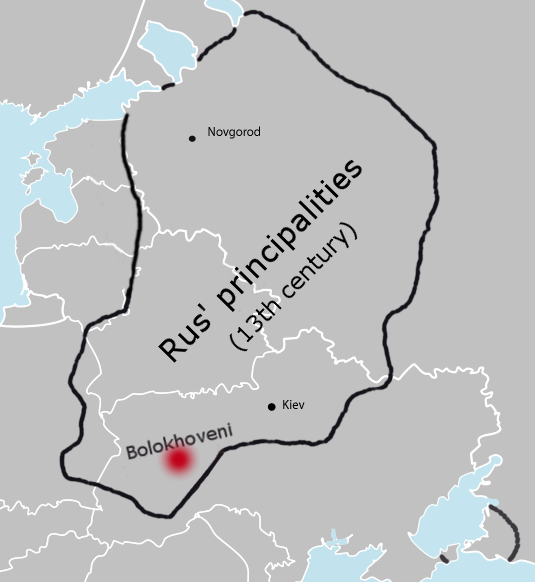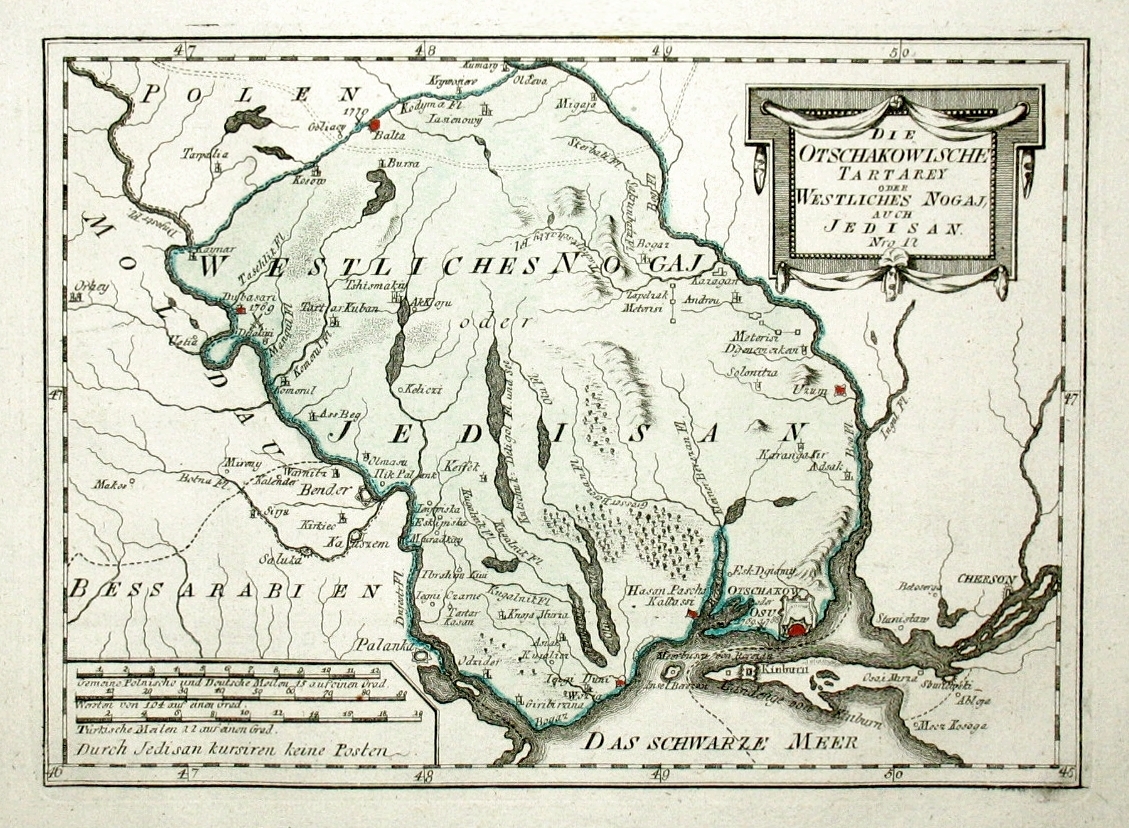|
Bolokhoveni
The Bolokhovians, Bolokhoveni or Bolokhovens (; Old Slavic: Болоховци, Bolokhovtsy) were a 13th-century ethnic group that resided in the vicinity of the principalities of Galicia, Volhynia and Kiev, in the territory known as the "" centered at the city of Bolokhov or Bolokhovo (not identified yet). Their ethnic identity is uncertain. Archeological evidence and the '' Hypatian Chronicle'' (which is the only primary source that documents their history) suggest that they were a Slavic people. Romanian scholars, basing on an interpretation of the ethnonym, identify them as Romanians (who were called Vlachs in the Middle Ages). Their princes, or ''knyazes'', were in constant conflict with Daniel, the prince of Galicia–Volhynia, between 1231 and 1257. After the Mongols sacked Kiev in 1240, the Bolokhovians supplied them with troops, but the Bolokhovian princes fled to Poland. The Bolokhovians disappeared after Daniel defeated them in 1257. Etymology The ethnonym seems ... [...More Info...] [...Related Items...] OR: [Wikipedia] [Google] [Baidu] |
Bolokhov
Bolokhov was a city mentioned in the '' Kievan'' and '' Galician–Volhynian'' chronicles, which gave the name to the , but that has not yet been found or identified. The currently known chronicle texts, like other historical sources, do not allow to determine the location of the city of Bolokhov with acceptable, sufficient archaeological accuracy. M. Dimnik claims that this land may have been located in the southwest corner of the Principality of Kiev and that it also shared borders with Volhynia and Galicia. According to Andrey Kuza, Bolokhov was located in modern-day Liubar. Mentions in chronicles According to historians, Bolokhov was located in the upper reaches of the Southern Bug, in the basins of the Horyn River with the Sluch tributary and the Teteriv River. This follows the mention of it in the '' Galician-Volhynian Chronicle'' of the 13th century. The very first mention is associated with the year 1150, when Vladimirko Volodarovich, the prince of Galicia, went from G ... [...More Info...] [...Related Items...] OR: [Wikipedia] [Google] [Baidu] |
Principality Of Galicia
The Principality of Galicia (; ), also known as Principality of Halych or Principality of Halychian Rus, was a medieval East Slavic principality, and one of the main regional states within the political scope of Kievan Rus', established by members of the oldest line of Yaroslav the Wise's descendants. A characteristic feature of the Galician principality was the important role of the nobility and citizens in political life, and consideration a will which was the main condition for the princely rule. Halych as the capital mentioned in around 1124 as a seat of Ivan Vasylkovych the grandson of Rostislav of Tmutarakan. According to Mykhailo Hrushevsky the realm of Halych was passed to Rostyslav upon the death of his father Vladimir Yaroslavich, but he was banished out of it later by his uncle to Tmutarakan. The realm was then passed to Yaropolk Izyaslavich who was a son of the ruling Grand Prince Iziaslav I of Kiev. Prehistory The first recorded Slavic tribes living in the regi ... [...More Info...] [...Related Items...] OR: [Wikipedia] [Google] [Baidu] |
East Slavic Languages
The East Slavic languages constitute one of three regional subgroups of the Slavic languages, distinct from the West Slavic languages, West and South Slavic languages. East Slavic languages are currently spoken natively throughout Eastern Europe, and eastwards to Siberia and the Russian Far East. In part due to the large historical influence of the Russian Empire and the Soviet Union, the Russian language, Russian language is also spoken as a lingua franca in many regions of the Caucasus and Central Asia. Of the three Slavic branches, East Slavic is the most spoken, with the number of native speakers larger than the Western and Southern branches combined. The common consensus is that Belarusian language, Belarusian, Russian language, Russian and Ukrainian language, Ukrainian are the extant East Slavic languages. Some linguists also consider Rusyn language, Rusyn a separate language, although it is sometimes considered a dialect of Ukrainian. The modern East Slavic languages desce ... [...More Info...] [...Related Items...] OR: [Wikipedia] [Google] [Baidu] |
Hungarians
Hungarians, also known as Magyars, are an Ethnicity, ethnic group native to Hungary (), who share a common Culture of Hungary, culture, Hungarian language, language and History of Hungary, history. They also have a notable presence in former parts of the Kingdom of Hungary. The Hungarian language belongs to the Ugric languages, Ugric branch of the Uralic languages, Uralic language family, alongside the Khanty languages, Khanty and Mansi languages, Mansi languages. There are an estimated 14.5 million ethnic Hungarians and their descendants worldwide, of whom 9.6 million live in today's Hungary. About 2 million Hungarians live in areas that were part of the Kingdom of Hungary before the Treaty of Trianon in 1920 and are now parts of Hungary's seven neighbouring countries, Hungarians in Slovakia, Slovakia, Hungarians in Ukraine, Ukraine, Hungarians in Romania, Romania, Hungarians in Serbia, Serbia, Hungarians of Croatia, Croatia, Prekmurje, Slovenia, and Hungarians in Austria, Aust ... [...More Info...] [...Related Items...] OR: [Wikipedia] [Google] [Baidu] |
Kingdom Of Galicia–Volhynia
The Principality or, from 1253, Kingdom of Galicia–Volhynia, also known as the Kingdom of Ruthenia, Kingdom of Rus', or Kingdom of Russia, also Halych–Volhynian Kingdom was a medieval state in Eastern Europe which existed from 1199 to 1349. Its territory was predominantly located in modern-day Ukraine, with parts in Belarus, Poland, Moldova, and Lithuania. Along with Novgorod Republic, Novgorod and Vladimir-Suzdal, it was one of the three most important powers to emerge from the collapse of Kievan Rus'. Roman the Great united the principalities of Principality of Galicia, Galicia and Principality of Volhynia, Volhynia at the turn of the 13th century. Following the destruction wreaked by the Mongol invasion of Kievan Rus' (1239–1241), Prince Daniel of Galicia and the other princes of Rus' pledged allegiance to Batu Khan of the Golden Horde in 1246. The Polish conquest of the kingdom in 1349 led to it being fully absorbed by Catholic Poland.Michael B. Zdan – The Dependence o ... [...More Info...] [...Related Items...] OR: [Wikipedia] [Google] [Baidu] |
Stara Ushytsia
Stara Ushytsia (; ; ) is a rural settlement in Kamianets-Podilskyi Raion, Khmelnytskyi Oblast, western Ukraine. Stara Ushytsia hosts the administration of Stara Ushytsia settlement hromada, one of the hromadas of Ukraine. The settlement's population was 2,492 as of the 2001 Ukrainian Census. Current population: Geography The town is situated on the banks of the Dnister River in the Podolian landscape. It is located near the National Environmental Park "Podilski Tovtry". History The settlement was first mentioned in written documents in 1144 as Ushytsia (). Ushytsia was also granted the Magdeburg rights in 1144. In 1826, the settlement was renamed to "Stara Ushytsia" (Old Ushytsia) while the settlement of Litnivtsi was renamed Nova Ushytsia (New Ushytsia). It was granted the status of an urban-type settlement in 1979. The town houses the Stara Ushytisa Settlement Council, which was founded in 1982. The council administers the town of Stara Ushytsia itself and the village of ... [...More Info...] [...Related Items...] OR: [Wikipedia] [Google] [Baidu] |
Dnieper River
The Dnieper or Dnepr ( ), also called Dnipro ( ), is one of the major transboundary rivers of Europe, rising in the Valdai Hills near Smolensk, Russia, before flowing through Belarus and Ukraine to the Black Sea. Approximately long, with a drainage basin of , it is the longest river of Ukraine and Belarus and the fourth- longest river in Europe, after the Volga, Danube, and Ural rivers. In antiquity, the river was part of the Amber Road trade routes. During the Ruin in the later 17th century, the area was contested between the Polish–Lithuanian Commonwealth and Russia, dividing what is now Ukraine into areas described by its right and left banks. During the Soviet period, the river became noted for its major hydroelectric dams and large reservoirs. The 1986 Chernobyl disaster occurred on the Pripyat River, a tributary of the Dnieper, just upstream from its confluence with the Dnieper. The Dnieper is an important navigable waterway for the economy of Ukraine and i ... [...More Info...] [...Related Items...] OR: [Wikipedia] [Google] [Baidu] |
Dniester
The Dniester ( ) is a transboundary river in Eastern Europe. It runs first through Ukraine and then through Moldova (from which it more or less separates the breakaway territory of Transnistria), finally discharging into the Black Sea on Ukrainian territory again. Names The name ''Dniester'' derives from Sarmatian ''dānu nazdya'' "the close river". (The Dnieper, also of Sarmatian origin, derives from the opposite meaning, "the river on the far side".) Alternatively, according to Vasily Abaev ''Dniester'' would be a blend of Scythian ''dānu'' "river" and Thracian ''Ister'', the previous name of the river, literally Dān-Ister (River Ister). The Ancient Greek name of Dniester, ''Tyras'' (Τύρας), is from Scythian ''tūra'', meaning "rapid". The names of the Don and Danube are also from the same Iranian word ''*dānu'' "river". Classical authors have also referred to it as ''Danaster.'' These early forms, without -''i''- but with -''a''-, contradict Abaev's hypoth ... [...More Info...] [...Related Items...] OR: [Wikipedia] [Google] [Baidu] |
Horyn
The Horyn or Haryn (, ; , ; ; ) is a tributary of the Pripyat, which flows through Ukraine and Belarus. The Horyn is long, and has a drainage basin of .Горынь It has a maximum width of 80 m, and a maximum depth of 16 m. An important tributary of the Horyn River is the Sluch. The Horyn takes its source in the of Ukraine, south of the city of [...More Info...] [...Related Items...] OR: [Wikipedia] [Google] [Baidu] |
Southern Bug
The Southern Bug, also called Southern Buh (; ; ; or just ), and sometimes Boh River (; ), at the Encyclopedia of Ukraine is a navigable river located in Ukraine. It is the List of longest rivers of Ukraine, second-longest river flowing exclusively in Ukraine. While located in relatively close proximity, the river should not be confused with Western Bug or Bug which flows in opposite direction towards Baltics. The source of the Southern Bug is in the west of Ukraine, in the Volhynian-Podolian Upland, about from the Polish border, from where it flows southeasterly into the Bug Estuary (Black Sea basin) through the southern steppes (see Granite-steppe lands of Buh park). It is long and drains . [...More Info...] [...Related Items...] OR: [Wikipedia] [Google] [Baidu] |
Teteriv
The Teteriv () is a right tributary of the Dnieper River in Ukraine. It has a length of and a drainage basin of . The Teteriv flows generally in northeastern direction through geographic regions of Podolian Upland, Dnieper Upland, and Polesia. The river starts near a populated place of Nosivky (previously Nosivka) near administrative border with Vinnytsia Oblast at over the sea level. Flowing through Podolian Upland in some areas it has characteristics of mountainous stream. In the underflow the valley of the Teteriv in Polissia on up to , the width of the river widens up to 40-90 meter, before it flows into the Dnieper. The midstream of Teteriv from Zhytomyr to Radomyshl has predominantly rocky banks. Few kilometers east of Radomyshl turns into fully flatland river within Kyiv Oblast. Further east of Ivankiv turns into a swampy wetland. The river drains into the Dnieper in the Kyiv Reservoir just south of the Prypiat river estuary and the Chernobyl exclusion zone. The Tete ... [...More Info...] [...Related Items...] OR: [Wikipedia] [Google] [Baidu] |





